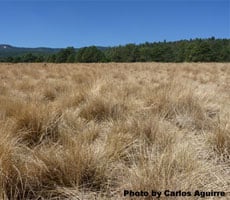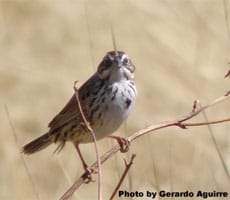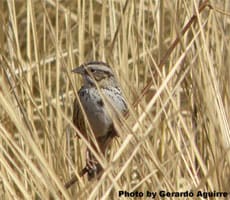
Sierra Madre Sparrow (Xenospiza baileyi) is an endemic species found only in high elevation temperate grasslands of western and central Mexico. It is listed as in danger of extinction (Birdlife 2011; IUCN 2011, and NOM-SEMARNAT-059-2010). Historic observations exist from at least seven sites in Mexico: two in Durango, one in Jalisco, and four in the south of the Valley of Mexico. Nevertheless, basic information about this species is practically unknown. Our research aims to generate baseline information for the conservation of this species in the Sierra de Durango.
The main objective of our research is to undertake an ecological study of Sierra Madre Sparrow to fill basic information gaps. The proposal is to identify potential habitat through remote sensing techniques and geographic information systems, characterize habitat based on measurements of the principle vegetative attributes, evaluate population size, determine reproductive success, and analyze genetic variation in order to understand population structure.

To date we have identified four potential sites for Sierra Madre Sparrow: Bajía de Aguinaldos, Navíos, La Herradura, and Paraíso de la Sierra. We began weekly monitoring efforts at the first three sites in June 2011, while at Paraíso de la Sierra we began in September 2011. The habitat structure at each location includes large patches of Muhlenbergia macroura-dominated grasslands (a species that has been identified as an essential component for the presence of Sierra Madre Sparrow) interspersed amidst pine-oak forests. The only site in which Sierra Madre Sparrow has actually been detected is Paraíso de la Sierra, where we observed three individuals in September 2011. In addition to the four sites described above, since June 2010 we have also conducted weekly monitoring transects at Bajía Largo, part of Ejido Ojo de Agua del Cazador, where Sierra Madre Sparrow has been observed since 2004. During these counts we observed a maximum of 18 individuals (23 June 2011) and 16 individuals (29 June 2011).
We have found that the population of Sierra Madre Sparrow decreases with decreasing temperature. Accordingly, we have not detected any individuals between October 2010 and February 2011. Numbers begin to increase in March and we found the maximum number of individuals in the month of June.

Of the five sites where we have undertaken monitoring efforts, we have only detected Sierra Madre Sparrow in two and in very low densities. This supports prior statements that the long-term survival of this species is an issue of concern and requires a plan for conservation and restoration of habitat, with the ultimate goal of conserving and increasing the population of Sierra Madre Sparrow in the region.
Contact Miguel Angel Cruz, Pronatura Noroeste’s Director of Bird Conservation, to learn more about this research.
